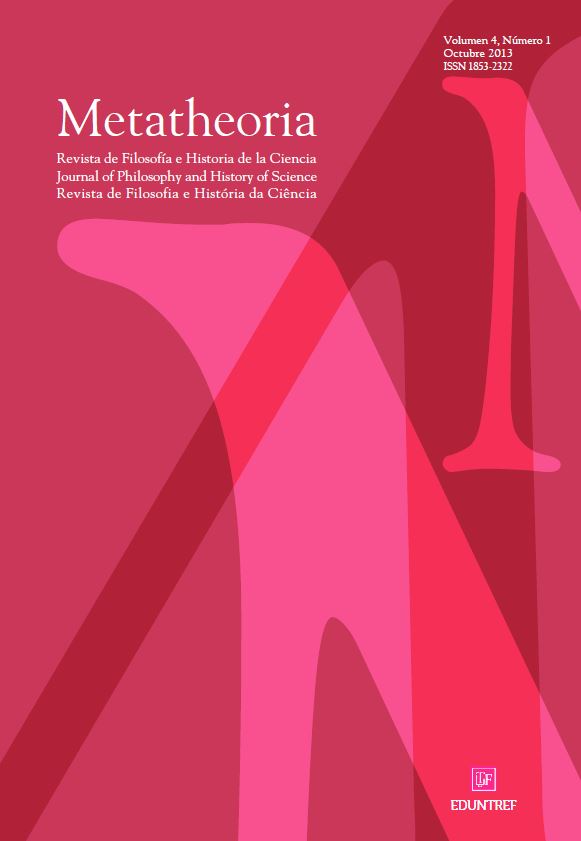The Metaphor of the Stranger in the Historical Narrative of Science
DOI:
https://doi.org/10.48160/18532330me4.111Palavras-chave:
history of science, sociology of scientific knowledge, historical narrative, historical distanceResumo
The recognition by the sociology of scientific knowledge of the artifactuality and contingent character of scientific knowledge has resulted in considering the canonical narrative forms of history of science as unsustainable (Golinski 1998). However, Kuukkanen (2012) holds that the social turn in the historiography of science has led to the adoption of social research models, which therefore caused the empirization of the field and prevented the appropriation of narrativist contributions to the theory of history. This paper analyzes the way in which the metaphors of the stranger are used as historical distancing devices in Leviathan and the Air-Pump by Shapin and Schaffer. The examination of these devices constitutes a means of entry into historical narrative that allows us to evaluate the acceptance of the figural character in this historiographical production.Referências
Austin, J. (1962), How To Do Things With Words, Oxford: Oxford University Press.
Auerbach, E. (2003), Mimesis: The Representation of Reality in Western Literature, Fiftieth An-niversary Edition, translated by W. Trask, Princeton: Princeton University Press.
Barthes, R. (1966), “To Write, an Intransitive Verb?”, in Barthes, R. (ed.), The Rustle of Lan-guage, Berkeley: California University Press, pp. 11-21.
Bauman, Z. (1991), Modernity and Ambivalence, Ithaca, N. Y.: Cornell University Press.
Clark, W. (1995), “Narratology and the History of Science”, Studies in History and Philosophy of Science 26(1): 1-71.
Douglas, M. (1975), Implicity Mining. Ensays in Anthropology, London: Routledge.
Douglas, M. ([1966] 2001), Purity and Danger. An Analysis of the Concepts of Pollution and Taboo, New York: Routledge.
Galison, P. (1991), “History, Philosophy and the Central Metaphor”, Science in Context 2(1): 197-212.
Golinski, J. (2005), Making Natural Knowledge. Constructivism and the History of Science, Chicago: The Chicago University Press.
Kuukkanen, J.-M. (2012), “The Missing Narrativist Turn in the Historiography of Science”, History and Theory 51: 340-363.
La Greca, M. I. (2012), “El valor de la narratividad en Hayden White: crítica, ambivalencia y escritura de la historia”, in Tozzi, V. and N. Lavagnino (eds.), Hayden White, la escritura del pasado y el futuro de la historiografía, Buenos Aires: EDUNTREF, pp. 227-241.
Latour, B. ([1991] 1993), We Have Never Been Modern, Cambridge: Harvard University Press.
Latour, B. (1999), Pandora’s Hope. Essays on the Reality of Science Studies, Cambridge: Harvard University Press.
Latour, B. (2005), Reassembling the Social. An Introduction to Actor-Network Theory, Oxford: Oxford University Press.
Lévi-Strauss, C. ([1955] 1961), Tristes Tropiques, London: Hutchinson & Co.
Martini, M. (2013), “El modelo figural para una historia de la historiografía de la ciencia”, História da Historiografia 12: 137-154.
Phillips, M. S. (2011), “Rethinking Historical Distance from Doctrine to Heuristic”, History and Theory 50: 11-23.
Pickering, A. (1985), The Mangle of Practice: Time, Agency, and Science, Chicago: University Chicago Press.
Rheinberger, H.-J. (1994), “Experimental System: Historiality, Narration, and Deconstruction”, Science in Context 7(1): 65-81.
Rouse, J. (1991), “Philosophy of Science and the Persistent Narratives of Modernity”, Studies in History and Philosophy of Science 22(1): 141-162.
Schütz, A. (1944), “The Stranger: An Essay in Social Psychology”, American Journal of Sociology 49(6): 499-507.
Simmel, G. (1971), On Individuality and Social Forms. Selected Writings, Chicago: University of Chicago Press.
Shapin, S. and S. Schaffer (1985), The Leviathan and the Air Pump, Princeton: Princeton Uni-versity Press.
Tozzi, V. (2009a), La historia según la nueva filosofía de la historia, Buenos Aires: Prometeo.
Tozzi, V. (2009b), “Hayden White y una filosofía de la historia literariamente informada”, Ideas y valor 140: 73-98.
Tozzi, V. and N. Lavagnino (eds.) (2012), Hayden White, la escritura del pasado y el futuro de la historiografía, Buenos Aires: EDUNTREF.
White, H. (2010), “Writing in the Middle Voice”, in Doran, R. (ed.), The Fiction of Narra-tive: Essays on History, Literature, and Theory, 1957-2007, Baltimore: The Johns Hopkins University Press, pp. 255-262.
White, H. (1999a), “Auerbach’s Literary History. Figural Causation and Modernist Histori-cism”, in White, H., Figural Realism: Studies in the Mimesis Effect, Baltimore: Johns Hopkins University Press, pp. 87-100.
White, H. (1999b), “Posmodernism and Textual Anxieties”, in Stråth, B. and N. Witoszek (eds.), The Postmodern Challenge: Perspectives East and West, Amsterdam: Radopi, pp. 27-46.
White, H. (1992), “Historiography as Narration”, in Morris, H. and J. H. Smith (eds.),Telling Facts: History and Narration in Psychoanalysis, Baltimore: Johns Hopkins University Press, pp. 284-299.
White, H. (1987), “The Value of Narrativity in the Representation of Reality”, in White, H., The Content of the Form: Narrative Discourseand HistoricalRepresentation, Baltimore and London: Johns Hopkins University Press, pp. 1-25.
Downloads
Publicado
Como Citar
Edição
Seção
Licença
Copyright (c) 2013 Metatheoria – Revista de Filosofia e História da CiênciaOs documentos publicados aqui são regidos pelos critérios de licenciamento Creative Commons Argentina.Atribución - No Comercial - Sin Obra Derivada 2.5





